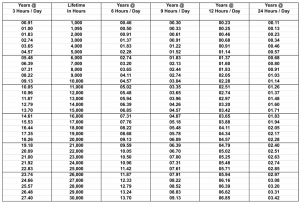Published February 28, 2017 at 01:11 AM
Updated February 28, 2017 at 01:11 AM
You may wish to see this other article for lots of additional detail on LED light bulbs:
https://techstarship.com/2016/06/02/42-things-you-need-to-know-ultimate-led-light-bulb-buying-guide/
Also see the Incandescent Light Bulb Watts Versus Lumens article:
https://techstarship.com/2014/12/17/incandescent-bulb-watts-versus-lumens-chart/
Hi all. I’ve been shopping for LED light bulbs again and am trying to expunge the last remaining fluorescent and incandescent bulbs from my house. I think there’s only one or two of those old bulbs left in the house now.
So, I was out shopping and, once again, I was getting frustrated by the way that the lifespans are reported. I personally find them to be misleading. Now, it is true that they used to be very inconsistent and now the industry has pretty much stabilized on a consistent method. However, I believe they’re labeled in such a way that customers will still be confused. I’m pretty sure this applies to CFL bulbs as well but I’m not shopping for them nor am I shopping for incandescents.
The packaging for most LED bulbs out there has a semi standardized information panel that lists the PROJECTED lifespan of the bulb. Most of the industry has standardized on listing the projected life at 3 hours of use / day. I don’t think that’s representative of the way most people use most of their light bulbs. Maybe I’m unusual, but I use many of my bulbs much more than 3 hours / day.
So, the problem is that the packaging gives you an overly optimistic picture of the bulb’s lifespan. Kind of like copier toner cartridges rated for only 15% coverage of toner on the page. But that’s another story.
So, I decided to do what little I can about it. Below I present my LED Bulb Lifetime Chart.
The above small image links to a larger one. That may be more or less clear on your screen depending on how you scale it. You can experiment with that for best results. You can also try the pdf at the following link. The pdf is better for printing and may display better on your screen.
https://techstarship.com/wp-content/uploads/2017/02/led-lifetime-chart.pdf
So, here’s how to use it to get some more clarity about the lifetime of LED or CFL bulbs assuming they’re rated for projected life at 3 hours / day.
The 2nd column shows bulb lifetime in hours. This is what you generally won’t see on the package, or if you do, it’s hard to find. It lists hours by increments of thousands with one exception. The 2nd line shows 1095. If you multiply 365 days times 3 hours / day, this is what you get. The entire chart uses multiples of this number to figure out bulb life under various use cases.
The first column back tracks from the 2nd column to figure out the life in years that is equivalent to a certain number of hours at 3 hours / day.
First, find the number in the 1st column that’s closest to the life listed on the bulb package and you may wish to round down. Making up an example, say the bulb package says it lasts 12.9 years at 3 hours / day. The next lower number in the 1st column of the chart is 12.79. Following this line to the 2nd column shows 14,000 hours. Thus, the bulb should last between 14,000 and 15,000 hours. You could easily print and clip out the first two columns of the chart and put them in your pocket.
This is useful in itself. However, the rest of the columns provide more data. In our example, following the 14,000 hour line across, you can find the projected life of the bulb when using it 6 hours / day – 06.39 years, or 9 hours / day – 04.26 years, or 12 hours / day – 03.20 years, or 24 hours / day – 01.60 years. Using this, you can determine the projected life span based on a potentially more realistic usage pattern. Yes, you could do all that with a calculator, but the chart makes it much more convenient.
Now, let’s take it a step further. What about the warranty? Find the warranty verbiage on the packaging. This can take many different forms. Our example bulb was projected to last 12.9 years. The warranty may only last 10 years, or 5 years, or 3 years, for example. Note whether the warranty states that it lasts for a certain number of hours / day. For example, and subject to change, lower wattage Cree bulbs are currently warranted for 10 years. They don’t mention a number of hours / day. Other bulbs might say warranted for 3 years at 3 hours / day. If you find the next lowest number to 3 years in the 1st column of the chart and cross reference the 2nd column, you’ll find that 2.74 years at 3 hours / day equals 3,000 hours. So, in this hypothetical example, you could be buying a bulb that is projected to last a bit over 14,000 hours but which is actually warranted for only a bit over 3,000 hours. By following the 3,000 hour line across, you can see how many real world years your warranty lasts.
Hopefully, this chart will bring you some extra clarity and understanding when purchasing modern LED light bulbs. Enjoy.
Ron

